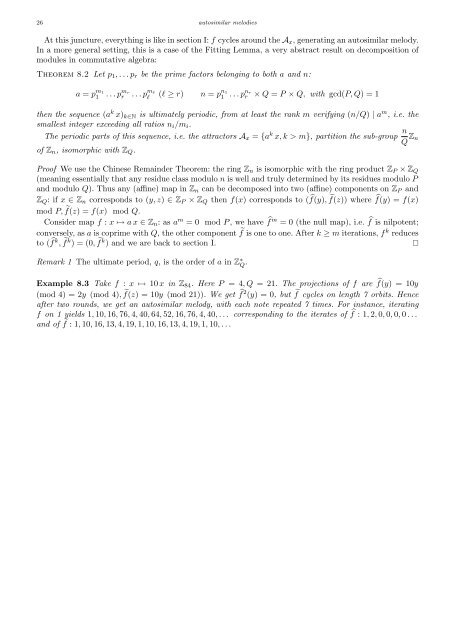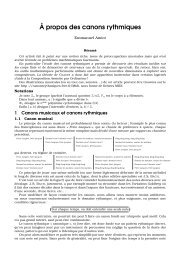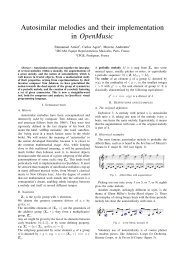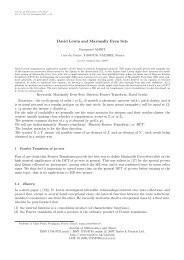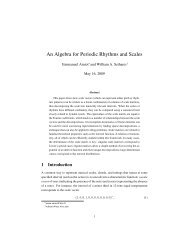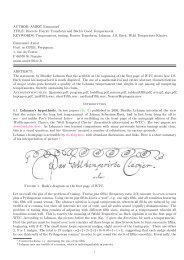Emmanuel Amiot Modèles algébriques et algorithmes pour la ...
Emmanuel Amiot Modèles algébriques et algorithmes pour la ...
Emmanuel Amiot Modèles algébriques et algorithmes pour la ...
You also want an ePaper? Increase the reach of your titles
YUMPU automatically turns print PDFs into web optimized ePapers that Google loves.
26 autosimi<strong>la</strong>r melodies<br />
At this juncture, everything is like in section I: f cycles around the Ax, generating an autosimi<strong>la</strong>r melody.<br />
In a more general s<strong>et</strong>ting, this is a case of the Fitting Lemma, a very abstract result on decomposition of<br />
modules in commutative algebra:<br />
Theorem 8.2 L<strong>et</strong> p1, . . . pr be the prime factors belonging to both a and n:<br />
a = p m1<br />
1 . . . p mr<br />
r . . . p mℓ<br />
ℓ (ℓ ≥ r) n = p n1<br />
1 . . . pnr r × Q = P × Q, with gcd(P, Q) = 1<br />
then the sequence (a k x)k∈N is ultimately periodic, from at least the rank m verifying (n/Q) | a m , i.e. the<br />
smallest integer exceeding all ratios ni/mi.<br />
The periodic parts of this sequence, i.e. the attractors Ax = {a k x, k > m}, partition the sub-group n<br />
Q Zn<br />
of Zn, isomorphic with ZQ.<br />
Proof We use the Chinese Remainder Theorem: the ring Zn is isomorphic with the ring product ZP × ZQ<br />
(meaning essentially that any residue c<strong>la</strong>ss modulo n is well and truly d<strong>et</strong>ermined by its residues modulo P<br />
and modulo Q). Thus any (affine) map in Zn can be decomposed into two (affine) components on ZP and<br />
ZQ: if x ∈ Zn corresponds to (y, z) ∈ ZP × ZQ then f(x) corresponds to ( f(y), f(z)) where f(y) = f(x)<br />
mod P, f(z) = f(x) mod Q.<br />
Consider map f : x ↦→ a x ∈ Zn: as a m = 0 mod P , we have f m = 0 (the null map), i.e. f is nilpotent;<br />
conversely, as a is coprime with Q, the other component f is one to one. After k ≥ m iterations, f k reduces<br />
to ( f k , f k ) = (0, f k ) and we are back to section I. <br />
Remark 1 The ultimate period, q, is the order of a in Z ∗ Q .<br />
Example 8.3 Take f : x ↦→ 10 x in Z84. Here P = 4, Q = 21. The projections of f are f(y) = 10y<br />
(mod 4) = 2y (mod 4), f(z) = 10y (mod 21)). We g<strong>et</strong> f 2 (y) = 0, but f cycles on length 7 orbits. Hence<br />
after two rounds, we g<strong>et</strong> an autosimi<strong>la</strong>r melody, with each note repeated 7 times. For instance, iterating<br />
f on 1 yields 1, 10, 16, 76, 4, 40, 64, 52, 16, 76, 4, 40, . . . corresponding to the iterates of f : 1, 2, 0, 0, 0, 0 . . .<br />
and of f : 1, 10, 16, 13, 4, 19, 1, 10, 16, 13, 4, 19, 1, 10, . . .


